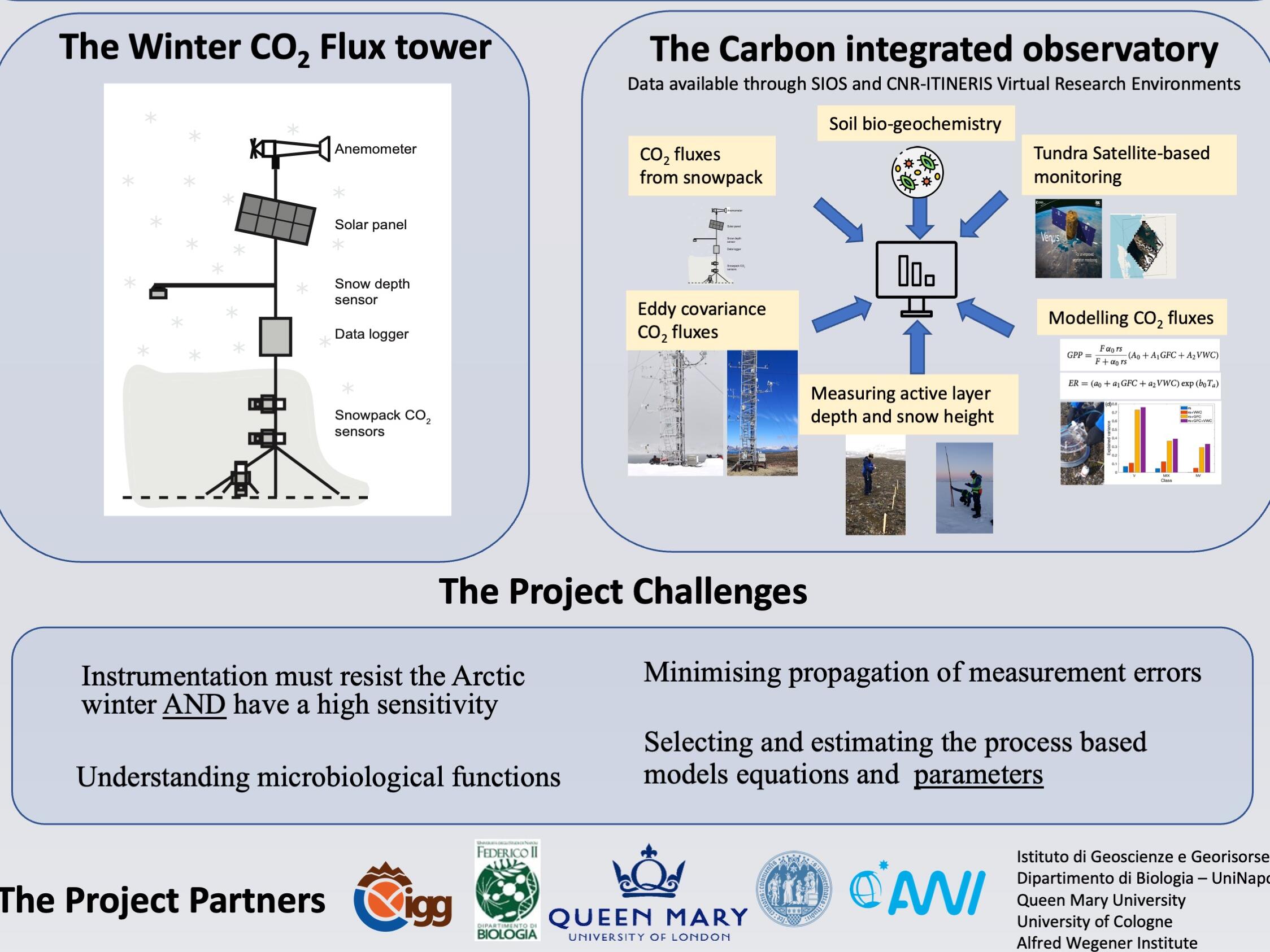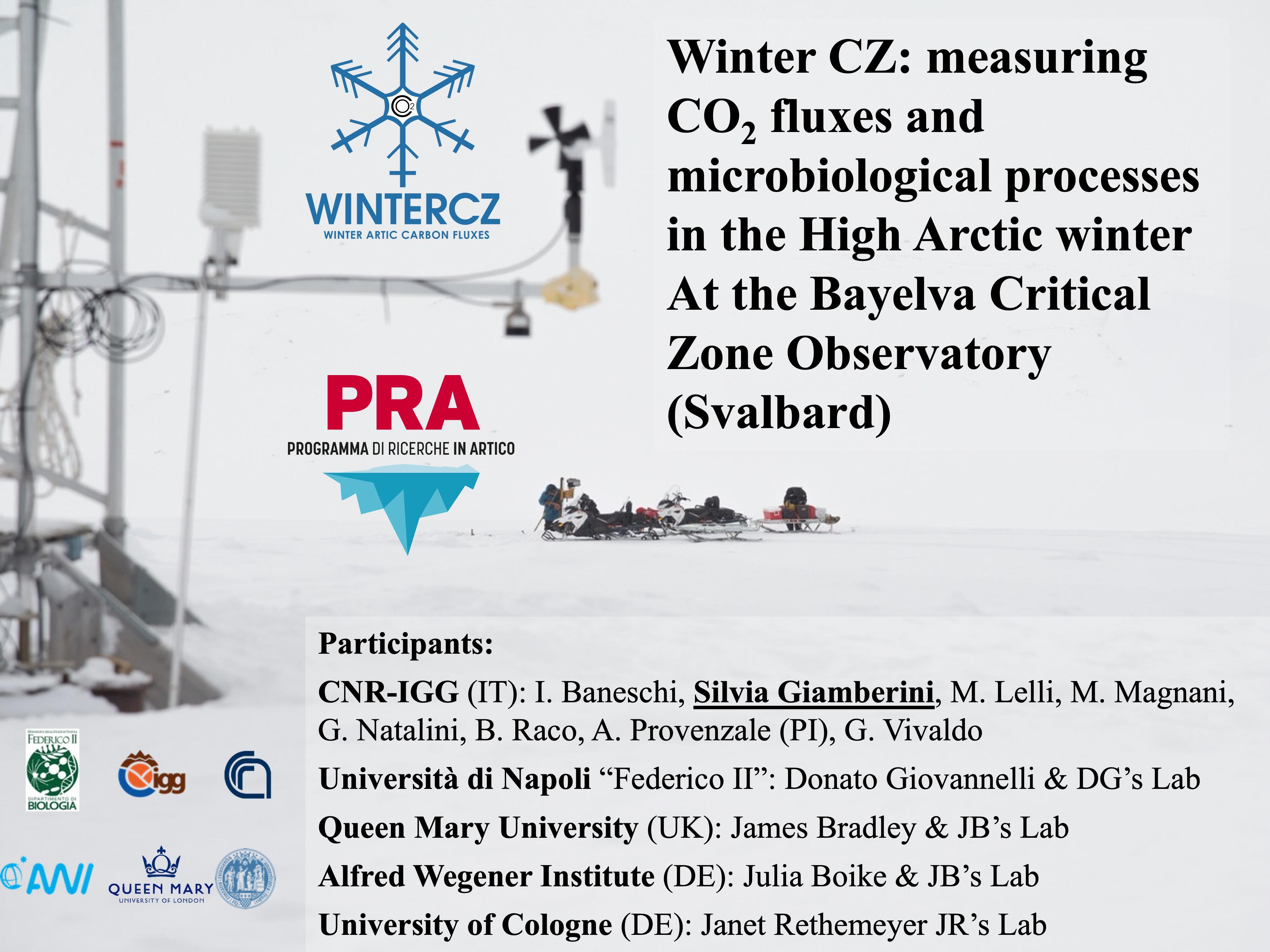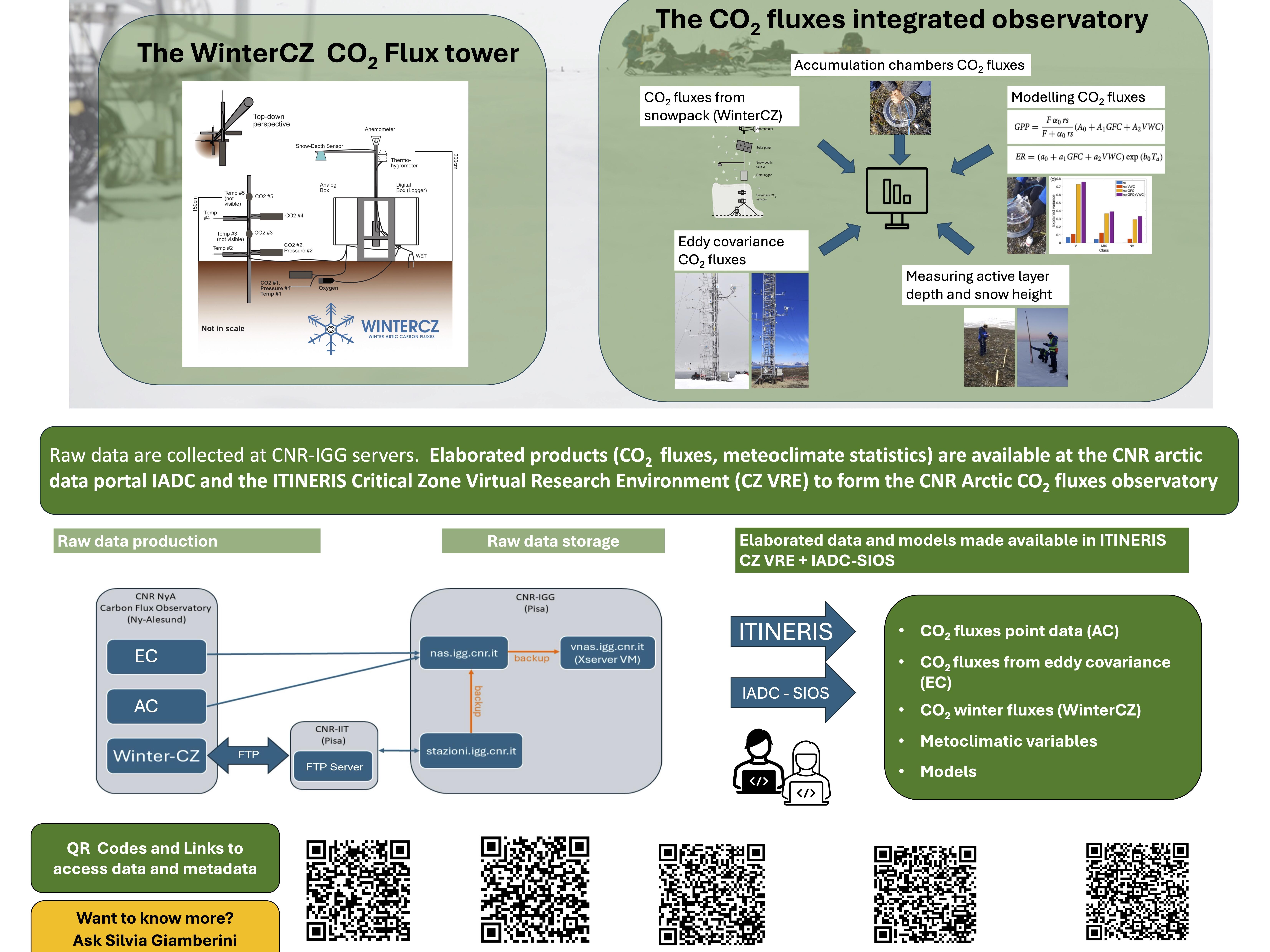- Acronimo
- Winter-CZ
- Area di ricerca
- Earth science
- Tematica specifica di ricerca
- Measurement and modelling of carbon fluxes from the snowpack in the high Arctic tundra
- Regione di interesse
- Svalbard; Ny Alesund; Bayelva Basin
- Sito web progetto
- https://www.winter-cz.it/
- PI
- Antonello Provenzale
- Istituzione PI
- Istituto di Geoscienze e Georisorse - Consiglio Nazionale delle Ricerche
- Sito web istituzionale
- https://www.igg.cnr.it/
- Altre Istituzioni e soggetti coinvolti
- Dipartimento di Biologia - Università di Napoli Federico II
- Consistenza del team ricerca
- Personnel involved: Researchers: 8 (He/him/his: 2 - She/her/hers: 6 - of which 1 non-permanent staff) Professors at University: 1 (He/him/his) PhD students: 2 (He/him/his) Engineers: 1 (She/her/hers) Grants: 1 (She/her/hers) (1 year)
- Stato progetto
- Completato
- Il progetto
Arctic CO2 fluxes are a crucial component of the global greenhouse gas balance and are linked with the state and annual dynamics of the tundra. The assessment of the flux magnitude and timing is crucial for quantifying the contribution to climate change generated by the positive feedback induced by Arctic soil respiration. Summer gas flux data are now available for several locations in the Arctic, including those performed by IGG-CNR at the Bayelva Critical Zone Observatory in Ny Ålesund (CO2 summer fluxes by flux chambers and year-round fluxes by Eddy Covariance) used to implement empirical models of CO2 fluxes. Existing data suggest, in fact, that during Winter the tundra could act as a weak carbon source. Winter processes, however, are poorly understood because of a lack of measurements spanning the ‘dark-season’.
The year-round dynamics of Arctic soil ecosystems are barely beginning to be explored, and therefore the soil geo-biological interactions and ecology during polar night are little known. Overall, winter CO2 flux dynamics is the great unknown in the annual Arctic carbon budget. This is a critical knowledge gap, because the amplified warming of the Arctic is strongest in winter, and yet most studies focus on the summer season. This constrains all models of Arctic soil carbon cycling with the assumption that soil microbes are mostly active during summer and summer-adjacent periods. In fact, while several studies show the active role of microbial communities in releasing greenhouse gases during summer thaw, their contribution to winter fluxes is not well studied.
Recent data show that Winter communities might be more stable than summer ones, and significantly contribute to organic carbon mineralization and continual release of CO2 even at sub-zero temperatures. Even the burst in greenhouse gases observed at the start of the thaw period might be due to the release of gases accumulated inside the frozen active layer during winter. Despite the potential role of specific winter microbial communities, few studies report their detailed characterization, usually on few winter time points, limiting our ability to link changes in the microbial communities with observed gas fluxes.
Furthermore, winter CO2 fluxes sometimes show strong flux bursts, associated with rapid changes in local air CO2 concentration and with strong wind bursts, as revealed by Eddy Covariance. Such processes can have multiple causes: strong winds can induce lateral gas diffusion within the snowpack, forcing CO2 -rich (or -poor) “bubbles” to emerge. Strong winds can also induce advective transport of CO2 -rich (-poor) air generated by other processes.
Building on recent work, we then propose to contribute to fill these knowledge gaps by complementing our already-existing flux-measuring infrastructure with a fixed state-of-the art instrumented tower for measuring CO2 fluxes from the snow (unique in Svalbard), and complemented by the analysis of soil physical-chemical properties, microbial composition and activity. The integrated collected data: a) will feed the new CNR NyA Carbon Flux Observatory, a FAIR data archive that will be created to contribute to the major pan-arctic databases; b) will be used to develop a model to explicitly simulate winter and year-round soil processes and enable the forecasting of biological and physical changes due to climate forcing, thanks to the modelling expertise of the proponents. This project will bring a technological advance of CNR infrastructure providing new services and products (data and models) and a new understanding of crucial processes in Arctic ecosystems and their two-way interaction with climate change.
- Immagini
-
- Motivazione, importanza della ricerca
Winter CO2 fluxes in the tundra contribute to the annual carbon budget, but their quantification is still scarce and scattered, as is the understanding of their controlling factors and dynamics. Microbiological activity is present in frozen soils, as the snowpack protects them from low temperatures. Strong winds also influence transport of CO2 through advective movements of air masses or enhanced diffusion in the snow. For these reasons, Eddy Covariance estimates are affected by significant uncertainty and must be complemented with measurements in the snowpack and soil, to disentangle the advective components from the biogeochemical contribution of the soil microbiological activity. At present, during winter only CO2 respiration into the soil is measured in Ny Ålesund; the only instrument to measure overall annual CO2 fluxes is the CNR-IGG Eddy Covariance at the CCT tower, and no in-situ continuous flux measurements are yet in place.
- Obiettivi della proposta
The project is aimed to build an Observatory of CO2 fluxes, to fill the knowledge gap on the properties and drivers of CO2 fluxes in the High Arctic. To complement the existing instrumentation, we installed a fixed station for measuring CO2 fluxes from snowpack and frozen soil; soil, snow and meteorological variables; and soil microbial composition and activity, for monitoring soil, snow, CO2 fluxes and microbiological activity in the Bayelva basin, during the snow-covered season, also developing data services and process-based models.
Such new multidisciplinary infrastructure provides full-year quantification of CO2 fluxes in the tundra, integrating flux measurements with environmental, geochemical and microbiological data. Its design is available to be replicated in other Arctic locations.
We established a new integrated CNR NyA Carbon Flux Observatory, producing FAIR data. The acquired data are aimed to reduce the uncertainty in the winter Arctic carbon budget and allows to develop data-driven and process-based models of the tundra CO2 dynamics.
The results will firmly place this project in the research landscape of Arctic winter CO2 fluxes, currently a major open research topic aimed at understanding the Arctic response to climate change. This project is a main Italian contribution to the international T-MOSAiC program. Open data policy will enhance its impact.
- Attività svolta e risultati raggiunti
The suite of sensors and meteorological station has been designed and installed in the tundra of the Bayelva Basin. The infrastructure for collecting and storing data, which form te CO2 Fluxes Observatory, has been set. The collection and elaboration of data is ongoing.
- Prodotti
The presentations and posters about the project, given at major arctic conferences and workshops between 2024 and 2023, are made available from this webpage. All the project's products, included the generated datasets, are available through the IGG-CNR Critical Zone Observatory community on Zenodo (https://zenodo.org/communities/igg-cnr-czo/). Data are also discoverable through the metadata webpage on the Italian Arctic Data Centre (IADC: https://metadata.iadc.cnr.it/)



